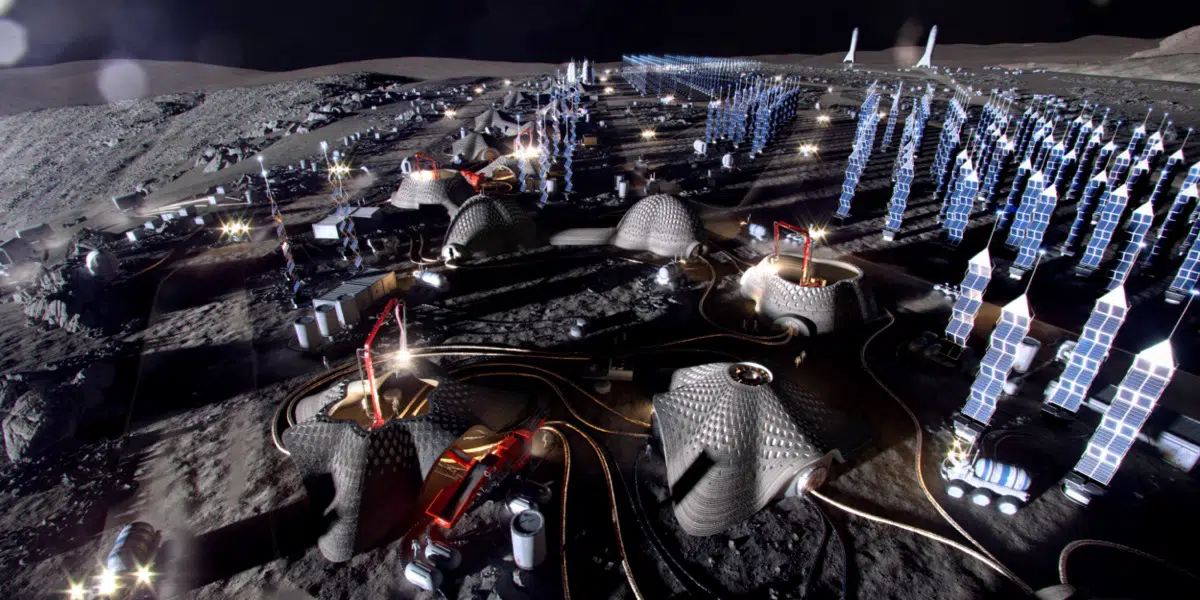Activities are set to intensify in 2022, as we get closer to the date (2024) that ESA and NASA have planned for humanity’s return to the Moon. The ESA Discovery program has been supporting groups from industry and academia to develop technologies for off-Earth manufacturing. Last November, a public online symposium presented their latest results and highlighted which technologies are most promising for maturing further towards integration into future space missions.
For long-term stays on the Moon and Mars, we would need to use local materials to build on location. Off-Earth manufacturing could be used to construct infrastructure that meets needs such as shielding crews and equipment from radiation, providing food and water, and generating electricity.
“Human exploration of the Moon and Mars is at the forefront of our minds, and space agencies are working on missions that would enable long-duration stays,” explained Advenit Makaya, advanced manufacturing engineer at ESA. “Now we should consider which technologies we need to develop to build the infrastructure required for sustainable stays on other planetary surfaces.”
“If we can find ways to manufacture long-term infrastructure in the difficult environment of space, we may be able to apply similar techniques to build more sustainable infrastructure here on Earth,” Makaya added.
For long-term stays on the Moon and Mars, we would need to use local materials to build on location. Off-Earth manufacturing could be used to construct infrastructure that meets needs such as shielding crews and equipment from radiation, providing food and water, and generating electricity. Throughout 2021, ESA’s Discovery program has been supporting groups from industry and academia to develop technologies for off-Earth manufacturing. These 23 activities came out of an Open Space Innovation Platform (OSIP) campaign for ideas for technologies that could enable off-Earth manufacturing and construction. By providing both funding and technical expertise to help teams build upon their initial ideas, the Discovery program is engaging with innovative researchers and helping young space companies enter an emerging field of space technology development. © SOM
AM for Off-Earth Manufacturing
Several of the solutions proposed involved additive manufacturing and some were related to the materials that could be used in AM processes. Jens Günster of BAM, the German Federal Institute for Materials Research and Testing, presented an ambitious study on large area sintering of regolith (which can be considered a type of ceramic material). Miranda Fateri of the University of Aalen, discussed a study titled Fused Layer Deposition of Regolith, via an extrusion 3D printer in a controlled environment.
Manufacturing on Demand
Going even more in-depth, EPFL researchers presented their work titled Incorporation of Additive Manufacturing and In-Situ Resource Utilization for future lunar exploration. The study focuses on the characterization of the reduced lunar regolith, with an investigation into the laser processing aspects of such feedstock via large-scale facilities (L-PBF) and the mechanical characterization of the additively manufactured parts. This work was conducted in collaboration with Metalysis.
Antonella Sgambati (OHB System AG), Christoph Hofstetter (Lithoz) and György Attila Harakály (Incus) presented the results of a research project on the Adaptation of the Lithography-based Ceramic Manufacturing (LCM) to process lunar regolith (LUPIN), along with the Novel Lithography Metal Manufacturing (LMM) process to produce highly accurate parts from recycled powder from scrap metals on the Moon.
A team from the University of Trieste presented their study on Off-Earth manufacturing through self-growing 3D printers, where they evaluated the feasibility of such a machine and also conducted tests on 3D printing in a vacuum of plant-based composites. The full set of presentations is available here.
“A big focus for the symposium is to encourage cross-fertilization between the ongoing activities and encourage a community to develop around off-Earth manufacturing technologies,” said Makaya. “We hope that this will be a step towards supporting this field of research which is seeing more and more activity in Europe.”
Open Space Innovation
The 23 activities that ESA’s Discovery program is supporting came out of an Open Space Innovation Platform (OSIP) campaign for ideas for technologies that could enable off-Earth manufacturing and construction. By providing both funding and technical expertise to help teams build upon their initial ideas, the Discovery program is engaging with innovative researchers and helping young space companies enter an emerging field of space technology development.
“ESA’s Discovery program is exploring the initial steps of future space markets and supporting innovative European industry to prepare for these markets,” explained Leopold Summerer, head of ESA’s Advanced Concepts and Studies Office. “Part of this means supporting companies that are not traditionally involved in space technology development; several of the selected activities will be implemented by start-ups that see a business case in space beyond the institutional stakeholders.”
* This article is reprinted from 3D Printing Media Network. If you are involved in infringement, please contact us to delete it.
Author: Davide Sher



Leave A Comment